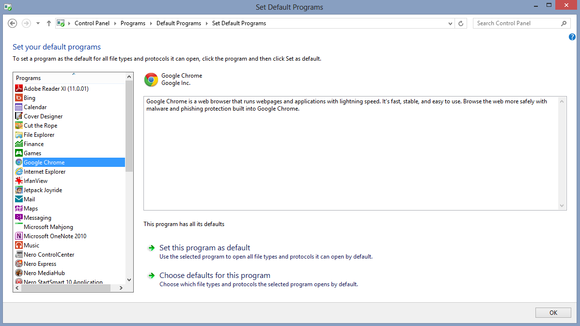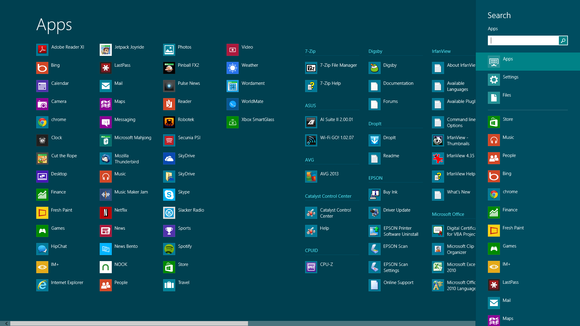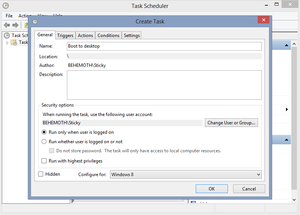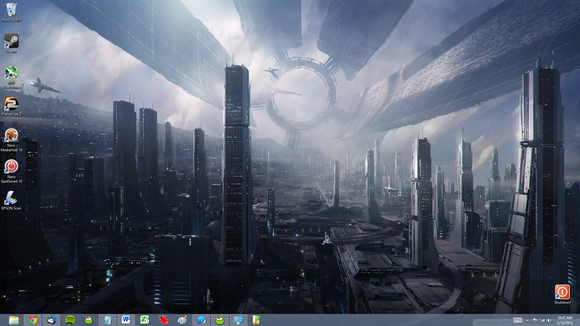How To Disable Metro Windows 8
In a earth exploding with tablets and touchscreens, Microsoft's decision to saddle Windows 8 with the finger-friendly Modern interface formerly known as Metro makes a lot of sense—for Microsoft. But if yous're amid the majority of Windows users who aren't using a tablet or a touchscreen, the focus on Live Tiles and mobile-centric apps is more than of a frustration than a feature. Vexingly, Windows 8 is riddled with sneaky ways to drag y'all out of the desktop and dump you lot on that shifting, shiny Start screen.
Windows 8 and its controversial interface will come preinstalled on practically every computer sold over the adjacent few years, but fright non! Die-hard desktop jockeys don't have to learn to stop worrying and honey the Live Tiles.
Here's a pace-past-step guide to banishing the Modernistic interface from your Windows viii life. Once it's gone, you might just come to appreciate Windows 8 even more than you exercise Windows 7. I take.
Set the phase

Given the Modern interface'southward deep hooks in Windows 8, it'south inappreciably surprising that cut the cord isn't an instantaneous one-snip procedure. Every major program you might demand for everyday utilize—from Mail to Messaging to Video—shows upward in Modern app form, rather than as a proper slice of desktop software. So earlier you can excise Modern, you lot have to find some desktop alternatives for the default apps.
Your critical mix will undoubtedly differ, simply I found that I could satisfy my basic needs with Thunderbird, a gratis e-mail customer that blows the pants off the Windows 8 Mail app; Digsby, a versatile IM client that works with a cornucopia of chatting services (different the Windows 8 Messaging app); the Spotify desktop app, to replace the sultry streaming tunes of the Windows viii Music app; the SkyDrive desktop app, which is far more flexible than its Modern app counterpart; and Google Chrome. (Sure, Windows 8 includes a desktop version of Net Explorer, just I adopt Google'south browser.) If yous want to be able to play DVDs on your Windows eight machine—something that Windows Media Role player doesn't do past default—I recommend picking upwardly VLC along with the other things you're busily downloading.
Once you've compiled a hefty stash of desktop programs, you lot'll want to make the most-used ones readily accessible, since Windows 8 lacks a Start push. Cluttering up your desktop with shortcuts is one approach, simply I prefer to pin icons for my well-nigh-used programs to the taskbar. Right-click a program and select Pin to Taskbar to practise just that. I use the same trick to pin a Control Panel icon to the taskbar.
Diddling with defaults

Next, y'all'll want to make those programs the defaults for opening their associated file types—to foreclose Windows viii from opening files with the Modernistic apps that send with the system. When you launch them for the starting time fourth dimension, many programs will inquire whether you'd similar to make them the default; just say yes!
At present either search for 'Default programs' on the Modern Start screen (we haven't banished it even so!) or select to Control Panel > Programs > Default Programs > Set your default programs. (That's why I like to have admission to Control Panel from the taskbar.) You lot'll see a listing of all of your PC's programs. Click each of your new desktop programs in turn, enabling it as the default option for its associated file types. If you didn't download VLC, be sure to enable Windows Media Player as the default for video and audio files, or you'll be dumped into one or the other of the Modern interface's slick, vapid Video and Music apps, whenever you open a media file.
Searches and First push replacements
Hither's where things get interesting. Just how much practice yous detest the Mod Windows 8 interface? The reply makes a crucial difference in how yous should suit to sift through your apps and search your organization.
If you absolutely, positively, soul-searingly loathe the new look of Microsoft's operating organization, y'all'll desire to download a program that restores the traditional Start button to the Windows viii desktop. That way, you'll never accept to return to the Windows 8 Starting time screen to search for specific software or files that aren't already pinned to your Taskbar or otherwise present on your desktop. Start8 and Archetype Trounce are excellent options for doing but that—and they give yous the option of booting direct to the desktop. Win-win!
After months of using Windows viii, twenty-four hour period-in and twenty-four hour period-out—both with and without Start push button Band-Aids—I recommend that you swallow your Modern misgivings in this solitary circumstance. Windows 8 has powerful search capabilities thatrock, and I've come up to capeesh them much more than the staid ol' Start button.

Biting this biting bullet doesn't mean swimming in Alive Tiles, though. Instead, you can create a desktop shortcut that rockets you direct to the Modern All Apps screen (or as I call it, my new and more efficient Start carte).
To practise so, right-click on your desktop and select New > Shortcut. Copy and paste the following text into the Location box, so click Next:
%windir%explorer.exe shell:::{2559a1f8-21d7-11d4-bdaf-00c04f60b9f0}
Give the shortcut a name—I went with the straightforward "All Apps"—then click Finish. At in one case, a shortcut to the All Apps screen appears on your desktop, which you tin pin to your taskbar if you so desire. The All Apps screen includes a full-screen list of all the programs on your reckoner, or you tin can start typing the name of a file to initiate a search.
Boot straight to the desktop
After you've gear up your desktop programs as defaults and sorted out your Start button dilemma, you lot demand to configure your PC to kicking directly to the desktop, bypassing the Windows eight Start screen.

First, open the Task Scheduler by typing Schedule task in the Settings search on the All Apps screen, or by deep-diving to Command Console > Organisation and Security > Authoritative Tools > Schedule Tasks.
One time the Task Scheduler is open, click Create Job under Task Scheduler Library in the Actions pane. Name your task "Boot to desktop" or something similar. Open up the Triggers tab, select New, and choose At log on in the 'Begin the job' drop-downwards carte at height. Click OK, and then open the Actions tab, select New in one case over again, and enter explorer in the Program/script field.
Salvage the action and the task, and you lot're washed! From now on, every time you log in to Windows, y'all'll automatically jump to the desktop, where an open Libraries binder volition greet y'all.
Setting up to shut down
Can yous sense of taste your future Metro-complimentary life? We're almost at that place. The concluding step involves creating a custom Shutdown button for your desktop, so that you won't have to "Swipe the charm bar"—the teenager in me only giggled—ever again.
Right-click any empty space on your desktop, and choose New > Shortcut. Re-create and paste the following text into the Location field, and and so printing Next:
shutdown /s /t 0
On the next screen, proper name the shortcut "Shutdown" and click Finish. The shortcut will appear on your desktop, sporting a generic icon. Swap the icon out past right-clicking the shortcut and choosing Properties. Open up the Shortcut tab and click the Modify icon button at the lesser. A big list of available icons will appear—I recommend using the Power button icon.
I also recommend placing the Shutdown shortcut far abroad from any other files on your desktop. The shortcut shuts your computer down immediately, without any warning or additional prompts, and it'due south a major pain if yous click information technology by accident.

That's information technology: You've banished the Mod interface from your Windows 8 life! If you've followed all of the instructions above—and opted to go the All Apps route rather than installing third-political party Offset button software—your desktop should look something like the 1 showwn in the screenshot. (The folder with the light-green pointer in the taskbar is the All Apps shortcut.) Enjoy Windows 8'south lightning-fast boot times and extensive improvements under the hood, without the abrasive new interface.
However feeling frisky? Technically, the Windows 8 lock screen doesn't have annihilation to do with the Modern interface; simply it'southward superfluous on a nontouchscreen figurer, and frankly its default inclusion simply serves every bit a reminder of Windows 8's tablet-starting time pattern. Stop it with farthermost prejudice (or at least with some quick configuration tinkering).
Search for "Run" or press Windows + R on your keyboard to open up the Run command. Type gpedit.msc and press Enter. Navigate to Computer Configuration > Administrative Templates > Control Panel > Personalization in the Local Grouping Policy Editor's left-hand card pane. Click the Practise Not Brandish the Lock Screen option that appears in the main pane, select the Enabled selection in the new window, and click OK to salvage your changes and never see the featherbrained lock screen once again.
Source: https://www.pcworld.com/article/456834/how-to-banish-metro-from-your-windows-8-pc-forever.html
Posted by: weeksmeren1965.blogspot.com

0 Response to "How To Disable Metro Windows 8"
Post a Comment